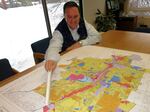Back in 2008, the city of Bend asked Oregon for permission to expand its urban growth boundary. The state said no.

J L Ward land manager Dean Wise points to the 350 acre swath of land just incorporated into Bend's new Urban Growth Boundary. He thinks it would be better served by being filled with single family homes, rather than commercial and industrial projects.
Kristian Foden-Vencil / OPB
First, it said the city needed to fill in some of the empty space inside the existing boundary.
Nine years later, Bend asked again. This time the state has given the go-ahead to grow by about 2,300 acres. But what the state wants to see built is very different from what some owners want.
Take long-time Bend development company J L Ward. Locals know their projects, places like Tillicum Village and Timber Ridge.
The company just saw a 350-acre swath of its land brought into Bend's new urban growth boundary. J L Ward manager Dean Wise thinks the land would be best used by sprinkling it with single family homes in between the trees.
"It'd be a shame to cut all the trees down, or a lot of the trees down, for large buildings and large parking lots," he said.
The company could make a lot more money building single family homes, too.
The problem they face is the state is requiring only a small percentage of the land be used for homes. State officials would like the rest developed for things like shops, schools and industrial parks.
Wise doesn’t think that’s going to work.
“We talked to folks … that would be potential buyers for that land and with different uses like grocery stores and other things. And they’re like: 20 or 30 years, maybe. In their minds, it was way out on the horizon in terms of when it could be developed for those kinds of uses,” Wise said.
J L Ward’s land is likely to stay empty for a while, even though bringing it into the urban growth boundary increased its value from $20,000 an acre to $50,000 or more an acre.

Dean Wise with J L Ward points to a plot of land just incorporated into Bend's new urban growth boundary.
Kristian Foden-Vencil / OPB
But across town, other people say J L Ward is thinking too small.
Erin Foote Morgan is with Bend 2030, a nonprofit that works with developers, residents and city councilors to come up with a vision of Bend’s future.
She said the city needs to build complete neighborhoods in some of these new areas.
“We will have industrial near employment lands, near residential lands, near commercial — so that you can, from your home, potentially bike the two miles to your work at an industrial manufacturing facility and then on your way home you can stop at the grocery store,” Morgan said.
Despite the difference between her vision and that of J L Ward, Morgan remains optimistic. She said if you offer developers the right incentive, they’ll build what the city wants. For example, give them a vertical tax credit and they’ll build taller buildings.
“If they’re building a duplex and they’re required to put one and a half car spaces for each unit, that means it’s only a duplex," Morgan said. "If you take away a little bit of the parking requirement, then you might be able to build a triplex, and you can really add the value to the property for yourself.”

Erin Foote Morgan of Bend 2030: “Bend (is) in this position of not having a visionary leader in many times. That the community has decided, I believe in what that person is saying."
Kristian Foden-Vencil / OPB
That discussion — how much to bend planning requirements to get what the city wants — will run over the next few months.
And the pressure’s on. Bend’s population is expected to increase 40 percent over the next 13 years.
Bend councilor Nathan Boddie said growth can’t be managed by just building single-family homes.
Bend’s vacancy rate for rental homes hovers at less than 1 percent. And it’s not much better for those trying to buy a home.
In fact, business owners will tell you they’ve lost many a good applicant because he or she simply couldn’t find somewhere to live.
“We have to create an affordable community across the income spectrum so that we continue to be a viable, economically profitable town. That’s how you attract business, that’s how you keep people here," Boddie said.
